Perhaps it’s because Newcastle is such an architecturally confused city that the very stuff of which it is built draws the eye as you walk up the side of the valley from the Tyne. There are the roughly hewn sandstone blocks of the remains of the medieval town wall, and the neater, more regular stones of the railway viaducts that criss-cross the city and lead to the bridges across the Tyne. There’s red clay and khaki brick: Georgian, Victorian, and modern. Aggregate concrete and asphalt make up the Pilgrim Street roundabout and the gigantic block of post-war flats that sits above it. There’s no evidence of coal, though, the mineral that helped make Newcastle a crucible of the industrial revolution. Once sooty smoke would have poured from every chimney, leaving its black stain on the proud civic buildings across the city, all of which have now been cleaned of grime. Down on the river, millions of tonnes of coal from Northumbria and County Durham poured into ships bound for the rest of the world: the wharves and docks are now silent, or demolished.
The North East’s coal, and those who dug it up, are the subject matter of this year’s AV Festival, which has been taking place under the title Extraction in various venues across the region over the month of March. This concluding weekend features an installation from Test Dept, the British fellow travellers of Einstürzende Neubauten and Laibach, in memory of both the local coal industry and those who fought to save it during the Miners’ Strike. It takes place on a cold March evening on Dunston Staithes, a gigantic wooden structure upriver from the city centre that was built to unload coal from railway trucks onto ships for transport around the UK and abroad. It now stands derelict, abused by tide and vandals and fire, nearly forgotten.
It’s not just in the architecture and monuments to Great Men With Serious Beards that you feel the history of Newcastle. Even the art galleries have glass cases displaying various local minerals, and in in the Laing Gallery paintings by local artists from the 18th century onwards depict industrial scenes along with landscapes of the surrounding countryside. Upstairs at Susan Stenger’s Sound Strata Of Coastal Northumberland, the minerals are represented on a long, thin cross-section of the geology of the North East, drawn and painted by Nicholas Wood in the 1830s. It slices through the landscape from Tynemouth (there’s a delicate little sketch of the ruin of the priory) via Alnmouth, to Dunstanborough Head (where Chris Watson made a recording as part of the Festival a few weeks ago) and Bamborough to the Tweed.
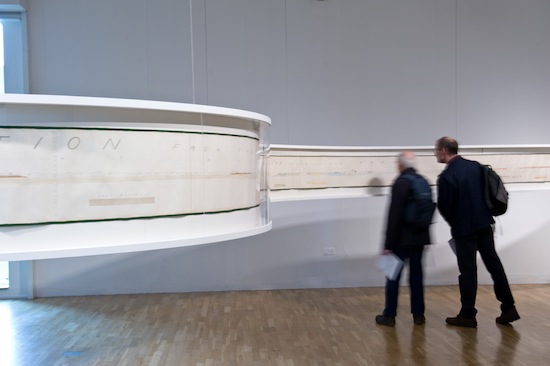
The faded watercolours represent basalt, shale sandstone, limestone, red sandstone and porphryitic rocks, and their plunge and rise, the strata of different ages, is reflected in Stenger’s audio accompaniment. She has composed an hour-long, gently shifting collage of local pipes, fiddles, brass and voices. Out of the bedrock of drone come pieces of melody, fragments of traditional songs and instrumentation. It’s a thoughtful evocation of the landscape beyond the city, and the memory of those who once toiled on, in, and under it. Around the corner, in a former branch of Abbey National Building Society, the reinforcing steel of a concrete slab for topping off an old mine shaft sits awkwardly and out of place in a white painted room, as people wait for the bus at the stop outside. Next door, workers put the final touches to a new branch of Santander.
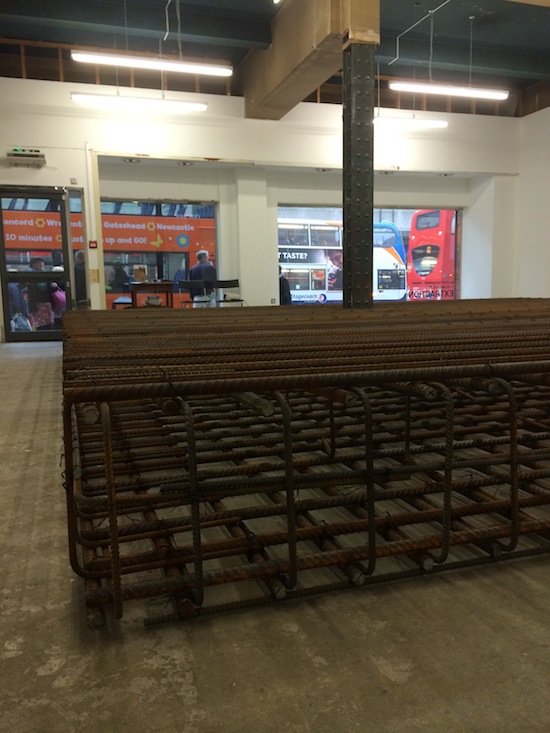
There’s not much in the way of heavy industry in Newcastle now, of course; a flight along the Tyne via Google Maps’ satellite view reveals huge patches of dark earth and faint lines where there were once shipyards, wharves, factories and their associated railway infrastructure. Yet so much of the world’s dirtiest and heaviest work began here. In sheds next to the still grand Newcastle Central station George Stephenson constructed the Rocket and Locomotion No.1, early locomotives that were designed to carry coal and minerals around the country. It’s a beautiful structure: whitewashed stone, graceful iron bars, leaded windows, businesslike wooden beams. In here, AV Festival are screening Chinese artist Wang Bing’s Crude Oil, a 14 hour film made up of long, fixed shots of the moon through cloud, drilling rigs, work camps.
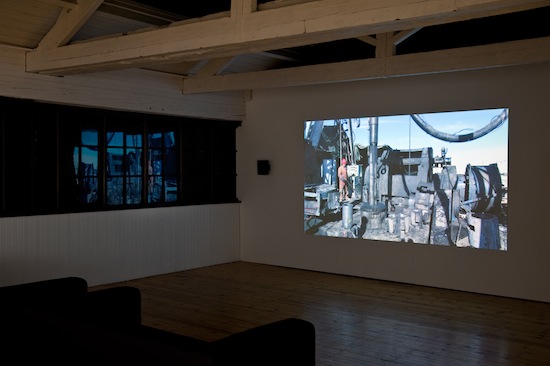
The thudding whisper of the wind on a microphone contrasts with men working, coupling drills and piping, dealing with all the dirt and grit. Elsewhere in the world, the heavy work goes on. This of course contributed to the decline of the pits here – not Chinese crude specifically, but other sources of coal and gas. This was progress, according to the Thatcher government, but it was not the kind of progress that built Newcastle and Gateshead as they expanded up from the River Tyne.
Now those waters are largely silent, with few vessels passing up and down. There is a fleet of three pleasure cruisers, which apparently usually host some very thirsty boating, and one of which we board after dark for the trip up the river to experience the Test Dept installation. As theatrical openings to an event go, the opening of the Millennium Bridge to allow our vessel to pass upstream towards the installation on Dunston Staithes is pretty spectacular – its two huge arches of steel tilt to raise the footway above the water. The 1876 swing bridge opens too, and speakers mounted on the open bow deck of the Latis start emitting clanking sounds. Above, the wind in the metalwork of the Tyne bridges makes an industrial music all of its own as we sail underneath. Even before the ship reaches the Staithes it’s clear that the brilliance of Test Dept here is to make everything, from the bridges to this vessel and the river itself, part of their artwork – maximalism on a scale you rarely see. The Staithes are a sentinel from the past, here to make a point, and everything else (coupled with the darkness), heightens the senses and pulls on emotions. We pass Ovaline Lubricants, a white building ghostly on the Gateshead side, facing the warm glow of more fancy riverside apartments on the other. It’s the same everywhere along former industrial rivers: places of toil, industry and communities replaced with unimaginative but lucrative redevelopments of bland flats with a Tesco Metro and a gym on the ground floor and a car park in the basement, little pods from which a relatively wealthy few can admire the water that once brought employment to many.
As we pass under the last two bridges high above, a lone spotlight reaches out of the darkness ahead. Then another, then light can be seen shining through the long, low, dark shape on the horizon, briefly revealing the brief flash and silhouette of the timber framework of Dunston Staithes. Gradually more and more of the structure becomes visible, via blue lights on the chutes that sent the coal roaring from truck to ship. One of them has a bush growing out of its base. The Latis stops and slowly spins in the river, and sound starts to come from the Staithes themselves, a two note, repeated blast.
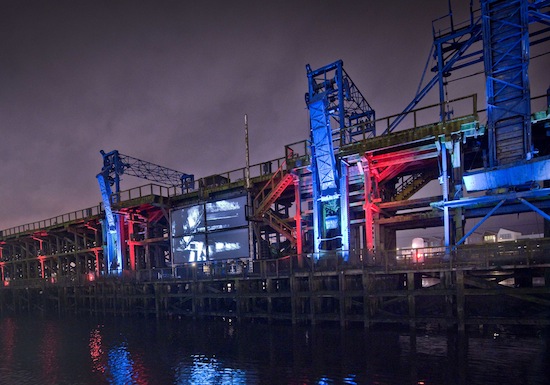
A large screen on the giant wooden pilings flickers into life, showing images and footage of the structure when in operation, featuring horses plodding through mine shafts, a map of all the sea routes coal took from Newcastle, and small trucks rattling on rails deep underground. Miners walk out of the light into the darkness of the pit, their silhouettes punctured by their head torches. We’re blasted with recordings of machinery, and a deep double heartbeat bass boom that seems to be coming from the boat. "It’s the bedrock of our British wealth and welfare," a voice thunders out.
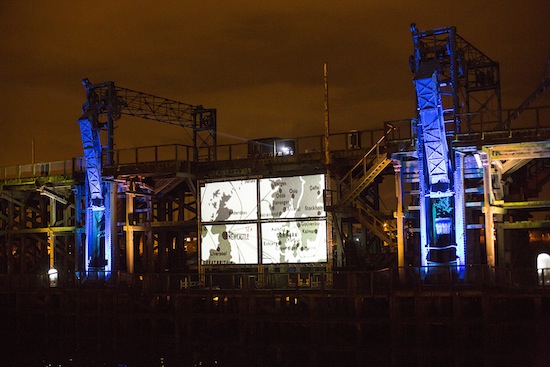
There are miners’ rallies, brass bands and people dancing, archive footage of Test Dept themselves hitting things, and gradually the rattling and noise and untraceable beats coalesce into something that I for one am dancing to, on the cold steel deck.
Of course, everyone knows what’s coming. A disembodied voice, what one might term a Westminster snivel, says "the realities of the present market". It’s a neoliberal catchphrase that, sometimes true, more often not, wreaks havoc and wrecks lives from Newcastle to Newquay, Nairobi to New Jersey. The footage becomes more intense, with policemen running, miners on the ground and a blur of batons, while Test Dept’s chains rattle and thud over spoken narrative of a beating at the hands of the law.
Then Arthur Scargill: "They’ve come for the miners, and I warn the rest of trade unionism that when they come for you there’ll be no one to protect you, because the police paramilitary operation will have succeeded." He’s followed by Thatcher in full flow, "coercion" "violence" "objectives" flying out of the screen in large white letters as she says them and the music reaches a scream. It’s a simple and clever trick, using her accusation against the miners’ tactics as a forced admission of the government’s own methods – it should be noted that Test Dept are supporting the project to film Seamus Milne’s The Enemy Within, his account of the police skull-cracking skulduggery used to break the strike.
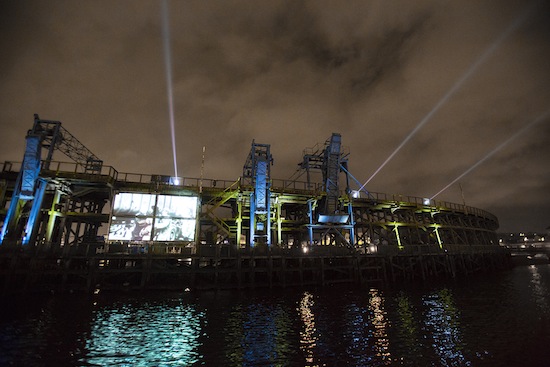
We watch pit head winch towers fall, now-and-then pictures show works and trains and tracks and pyramids of coal vanishing into the landscape. A map of the North East with pits marked in dots disappearing, footage of the miners again, and then women singing ‘Amazing Grace’, rough and ready, proud and strong, and then nothing, and the Staithes go dark. The audience are silent, the atmosphere thick not just with the Tyne mist, eyes watering not only thanks to the cold.
Dunston Staithes should not be this kind of monument. They should not require this kind of memorial. Test Dept themselves are an unfashionable relic of a misunderstood time – their particular brand of clattering industrial music has not had the same retrospective glow as many of their then-contemporaries. Their politics was always consciously direct, arguably militantly so, unlike the sensual nihilism of the more electronic groups from the Throbbing Gristle era. Test Dept’s political intent is also sadly lacking in all but a handful of contemporary noise or industrial groups.
Yet this exactly the sort of installation art that is important, that makes me wish we could charter a fleet of ferries and sail the British population up the Tyne past Dunston Staithes to witness this, to see how industry and employment was ripped out of so much of Britain, and replaced with nothing. Certainly from an environmental perspective, and arguably for economic reasons too, the coal mines had to close – but it doesn’t feel like Test Dept are suggesting they should have been preserved. Instead, they’re marking the fact that the means used to achieve Thatcher’s ends were wrong, that the ends themselves removed hope and pride for generations. Across the north of England and Wales, so little was done to replace livelihoods being lost. After all, the free market argument goes, people will travel to where jobs are. But you can’t uproot or ever replace the communities represented by those bright banners at the Miners’ gala. There’s not a moment tonight that feels dated, neither the music nor the message. Yes, the narrative Test Dept present is a partial and subjective one, but it’s not nostalgic, trite, not even bitter. It’s one that needs to be told, that’s never heard – my Quietus colleague Sophie Coletta remarks that, as someone born in the early 90s, the Miners’ Strike is never taught in schools, even around here. So what this is angry and beautiful, allowing forgotten and suppressed voices to emerge from the past and point out that our contemporary economic mess and rampant inequality is all part of one bleak continuum. It’s one of the most emotionally draining and inspiring pieces of political art or music I’ve ever witnessed.
The speakers on the boat pop back into life, and we hear the South Wales Striking Miners Choir singing ‘Take Me Home’, a song they recorded for a benefit release with Test Dept. "I remember the face of my father / as he walked back home from the mine," the voices sing, gentle yet strong, and the Tyne carries us back under the bridges, towards the sea.

